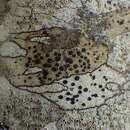en
names in breadcrumbs


Buellia disciformis, the boreal button lichen, is a thin, bluish to pale gray rimose to areolate crustose lichen that grows on bark (rarely also on wood) in temperate forests in the northern USA and Europe, and at high altitudes in Arizona, down to 500 metres (1,600 ft) in coastal areas of California.[1]: 230 [2] Flat apothecia with black discs are .2-.7 mm in diameter and sessile (neither raised or immersed in the thallus), with noticeable lecideine margins.[2][1]: 230 Lichen spot tests are negative except for K+ yellow.[1]: 230 Secondary metabolites include atranorin, fulgidin, and sometimes traces of fulgoicin and norfulgoicin.[2] B. erubescens is similar and more often found on wood than the bark loving B. disciformis, and has smaller spores.[1]: 230
Buellia disciformis, the boreal button lichen, is a thin, bluish to pale gray rimose to areolate crustose lichen that grows on bark (rarely also on wood) in temperate forests in the northern USA and Europe, and at high altitudes in Arizona, down to 500 metres (1,600 ft) in coastal areas of California.: 230 Flat apothecia with black discs are .2-.7 mm in diameter and sessile (neither raised or immersed in the thallus), with noticeable lecideine margins.: 230 Lichen spot tests are negative except for K+ yellow.: 230 Secondary metabolites include atranorin, fulgidin, and sometimes traces of fulgoicin and norfulgoicin. B. erubescens is similar and more often found on wood than the bark loving B. disciformis, and has smaller spores.: 230